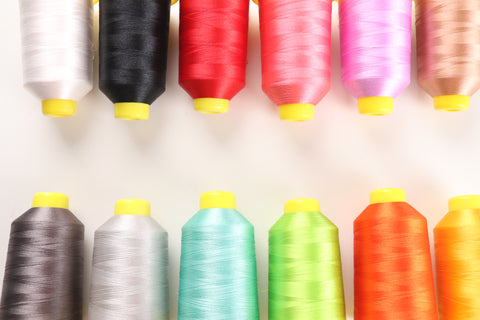
Your embroidery career may start with the old machine owned by your grandmother in your childhood, or from the beautiful patterns and badges sewn and embroidered by your mom, or from intending to open a professional embroidery shop, or from wanting to do something for yourself and your family in the spare time. In any case, you turned on the computer, surfed the Internet, chose an embroidery machine with a high score, opened the package, and started embroidering new patterns one after another according to the instructions. At this time, the thread brought by the machine ran out. You opened Amazon and searched for embroidery thread. "What the heck?" The screen is full of different materials, different sizes, different types, different weight and different functions. At that moment, you may want to sell the embroidery machine asap. lol
As a beginner in embroidery, how to choose the embroidery thread you need from a wide variety of embroidery threads? I hope this article can really help you.
Which is the best ? Rayon, Polyester or Cotton?
In fact, these three kinds of threads got their own advantages, which match different embroidery needs.Embroidery thread usually contains three main types: Rayon thread, polyester thread and cotton thread. There are also some special types, such as metallic thread / glowing in the dark thread / reflective thread / Rainbow thread, but for the purpose of this article, we only discuss these three basic threads.
Cotton: the favorite of old-fashioned embroiderers. Now it is most suitable for children's fabrics and famous brand fabrics. The finished products made of cotton thread are soft, comfortable to wear, good moisture absorption and air permeability, easy to iron and difficult to attract dust. But it is usually not as strong as rayon and polyester ones. It lacks elasticity and is easy to wrinkle and fade. The color is usually not so shiny and vibrant.
Rayon: Made of 100% viscose rayon, it is very suitable for embroidery on high-speed multi-heads embroidery machine and homeuse embroidery machine. Rayon thread is famous for its high tensile strength and soft luster. It is considered to be one of the best embroidery threads because of its high strength and wear resistance. Rayon has less abrasion than polyester thread, softer for the skin, and has strong hydrophilicity. Dry cleaning and water washing are not a problem, and is more gentle to the working parts of embroidery machine.
Polyester: polyester embroidery thread got high strength and is not easy to deform. It has advantages in eliminating looping, wrinkling and thread breakage. It has glossy color and good chlorine resistance, making it very suitable for commercial embroidery and family embroidery. Its disadvantage is that the fabric is hot and stuffy, which is easy to generate static electricity and attract dust. In short, polyester thread provides the best balance between cost and performance. It is an ideal thread for beginners.
40’S/2, 75D/2, 108D/2, 120D/2, What do these mean? How do I choose?
Don't worry, these refer to different specifications of embroidery thread. D refers to long fiber and S refers to short fiber. The specification of embroidery thread is expressed by the thickness and number of strands. If the specification of polyester silk embroidery thread is 120D/2, 120D, it indicates the thickness of the thread, while 2 indicates that the embroidery thread is made of 2 strands. D is the abbreviation of denier, a unit to measure the thickness of polyester yarn. The larger the number of D, the thicker the embroidery thread. On the contrary, the smaller the number of D, the thinner the embroidery thread.
The higher the yarn count of cotton thread, the finer the yarn, the thinner the woven cloth, and the softer and more comfortable the cloth is. Obviously, the higher the count of cloth, the higher the quality of raw materials (cotton), and the higher the requirements for yarn mills and weaving mills, so the higher the cost of cloth.
The general specifications of embroidery thread are: 150D/2, 120D/2, 108D/2, 75D/2, etc. The most commonly used specifications are: Rayon embroidery thread is 120d/2, polyester embroidery thread is 108D/2 and special thread is 150D/2. As a friendly reminder, perfect embroidery operation requires the perfect combination of thread and needle. We have popularized the choice of needle in previous articles.
Please check the following link:https://richword.com/blogs/news/learn-in-richword-lesson1-perfect-needle-perfect-work
What about the weight and length of the thread?
For beginners, the weight of the thread is a headache. We all see these numbers next to the online name. Have you ever wondered what these numbers mean? The most commonly used unit of weight on the market is WT.
WT is not simply weight, but determined by measuring the length of a gram of thread. If a gram of thread is 30 meters long, it is 30wt. The higher the number, the thinner the thread.
As for the weight of thread, it is easy to choose. Embroidery thread usually includes several different thread weight, the most common is 40wt, followed by thinner and lighter 60wt. 40wt thread should be your preferred thread for daily embroidery. When your design contains small details or small fonts, it is more suitable for 60wt thread; The length of the thread is more flexible according to you need, if you choose a longer thread, you may prepare a thread rack, which can effectively help you stabilize the embroidery thread and carry out the work.
I hope you can get the information you need in this article, www.richword.com provides embroidery threads that are suitable for all machines. We wish you a happy embroidery and life!
(Shawn Wang)














